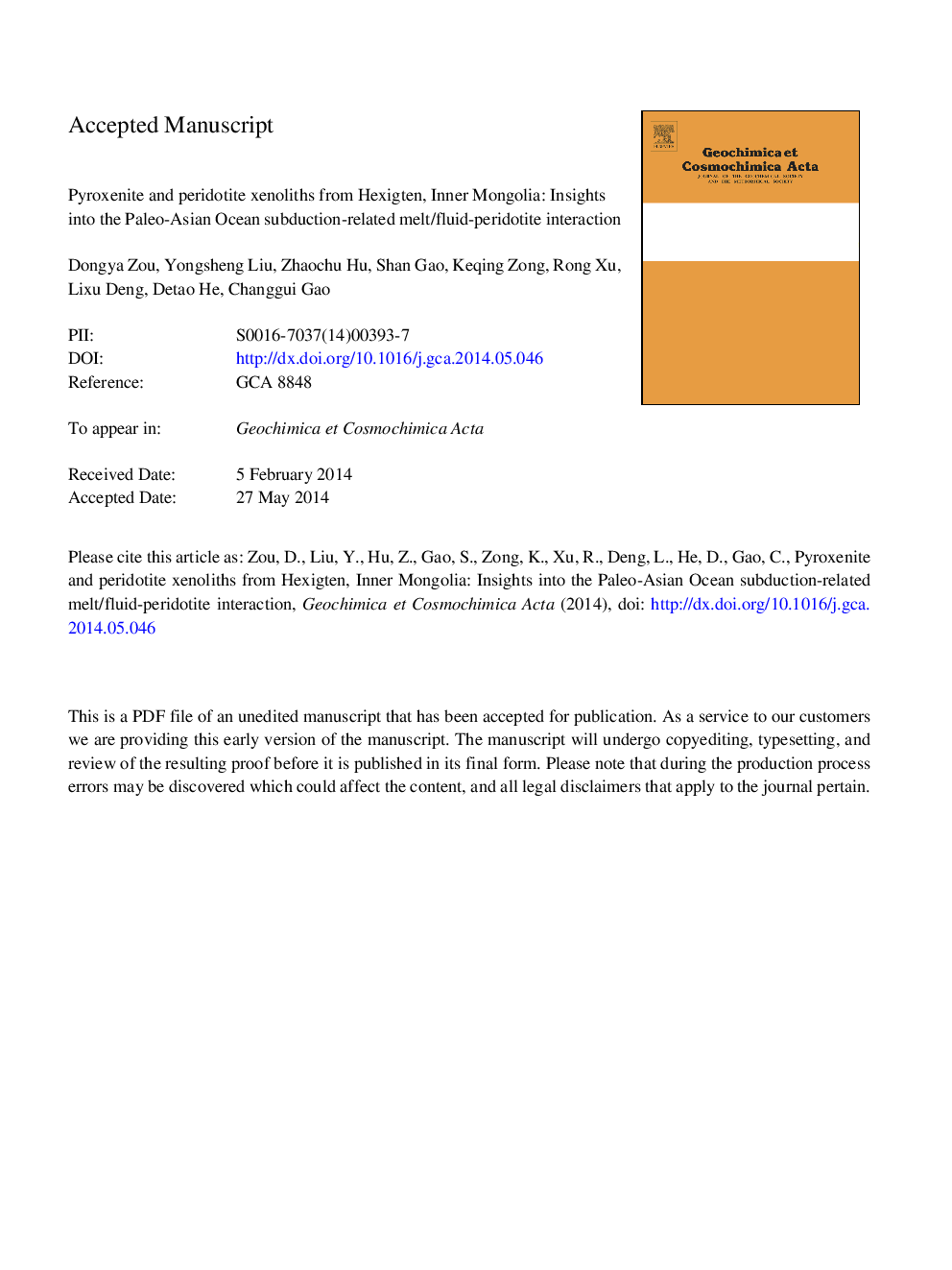| Article ID | Journal | Published Year | Pages | File Type |
|---|---|---|---|---|
| 6438388 | Geochimica et Cosmochimica Acta | 2014 | 57 Pages |
Abstract
The in situ major, trace-element and Sr-isotopic compositions of the peridotite and pyroxenite xenoliths from the Hexigten region in the Xing-Meng orogenic belt (XMOB) were examined to evaluate the influences and contributions of the Paleo-Asian Oceanic slab subduction on the lithospheric mantle transformation. Pyroxenes in the Type 1 pyroxenite exhibit low and variable Mg# (67-85) and relatively high 87Sr/86Sr ratios (0.7036-0.7053), indicating that they were formed by assimilation and fractional crystallization processes during a basaltic underplating event. The peridotite and Type 2 pyroxenite xenoliths sampled the lithospheric mantle and recorded subduction-related metasomatism. The mineral chemistries of the Type 1 peridotite suggest that the lithospheric mantle beneath this area suffered 1-15% melt extraction. Clinopyroxene (Cpx) in some Type 1 peridotites are characterized by high (La/Yb)N coupled with marked depletions in high field strength elements (HFSE) (Nb, Ta, Zr, Hf and Ti) and negative correlations between the low Ti/Eu (Nb/La) and 87Sr/86Sr ratios (0.7037-0.7055), suggesting metasomatism by subduction-related CO2-rich fluids. Olivine (Ol) and orthopyroxene (Opx) in the Type 2 peridotite are characterized by a relatively low Mg# but high Ni contents. In addition to the normal incompatible element-depleted Opx, Opx with enrichments in Rb, Ba, Th, U, Nb, Ta and LREE were observed, as well. The Mg# of incompatible element-depleted Opx exhibits weak zonations (i.e., decreasing from the cores to the rims). Cpx and Opx of the Type 2 pyroxenite exhibit similarly high Mg# and Ni contents. Rb, Ba, Th, U, Nb, Ta and LREE contents and 87Sr/86Sr ratios of the Cpx increase from the cores to the rims. Moreover, Opx in the Type 2 peridotite and Cpx in the Type 2 pyroxenite exhibit increased Nb/Ta ratios and Ni contents relative to those in the Type 1 peridotites. These observations collectively suggest a rutile-bearing eclogite-derived silicic melt-peridotite reaction as the origin for the Type 2 peridotite and pyroxenite. Considering the geological setting, it is suggested that the melt/fluid-peridotite interactions were caused by the Paleo-Asian Ocean subduction, which could have contributed significantly to the transformation of the lithospheric mantle beneath the northern margin of the NCC, as well.
Related Topics
Physical Sciences and Engineering
Earth and Planetary Sciences
Geochemistry and Petrology
Authors
Dongya Zou, Yongsheng Liu, Zhaochu Hu, Shan Gao, Keqing Zong, Rong Xu, Lixu Deng, Detao He, Changgui Gao,
